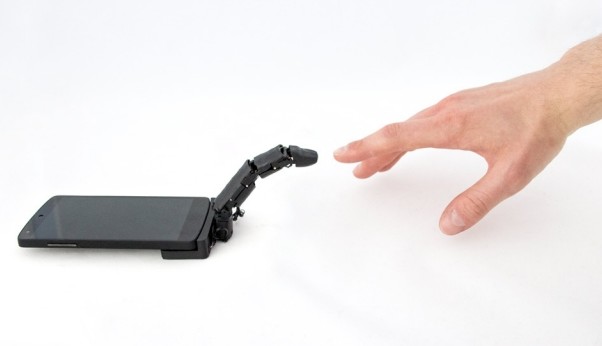Give your mobile a hand…
on

Well, yes, not an entire hand, but at least a finger! The MobiLimb is the tangible result of a research project by Marc Teyssier, Gilles Bailly, Catherine Pelachaud and Eric Lecolinet (Telecom ParisTech, Sorbonne and CNRS).
What is MobiLimb?
MobiLimb is an component that can change shape and can be attached to portable devices. It is a small serial robotic manipulator (with five degrees of freedom), which is easily added to (and just as easily removed from) existing devices (smartphone, tablet). Comparable to prostheses that can overcome the limitations of the human body, MobiLimb wants to overcome the limitations of mobile devices (static, passive, motionless) with the aid of a robotic finger.
Form factor
This approach leaves the form factor of the mobile device unchanged, and the efficiency of their I/O capabilities doesn't matter either – on the contrary: these are actually enhanced:
- users can manipulate the robotic finger and change the shape (input);
- they can see and touch the robotic finger (visual and tactile feedback), including, and particularly, when the shape is changed dynamically by the mobile device;
- as a manipulator, the robotic fingerer can be fitted with other modular elements (LEDs, sensors).
How is MobiLimb put together?

The hardware of the MobiLimb (image: Marc Teyssier).
MobiLimb comprises five moving joints and consists of four blocks: the actuators, the sensors, the embedded electronics and the controller.
For the actuators five PZ-15320 servo motors are used, which are sufficiently powerful. The first two motors are placed orthogonal to each other on the base and they carry the other three, which are mounted one after the other. A 3D-printed structure holds the motors together without restricting their movement. The servo motors provide their position (angle of rotation) as feedback. Based on this the position can be calculated. Additionally, a flexible potentiometer is provided that detects when the user touches the MobiLimb.
The base of the MobiLimb contains an Arduino Leonardo Pro Micro, which takes care of the control.
The researchers have developed an Android/Unity API that allows animations to be made, stored and replayed. For the connection between Arduino and Unity a Udunio is used.
Aesthetics
Several ‘coverings’ have been developed: a classic robotic finger, one with fur and finally one that looks like a ‘real’ finger (made from the same material that is also used in the film industry).
UIST
MobiLimb will be officially presented at the User Interface and Technology Symposium (UIST) in Berlin, from 14 to 17 October 2018.


Discussion (0 comments)